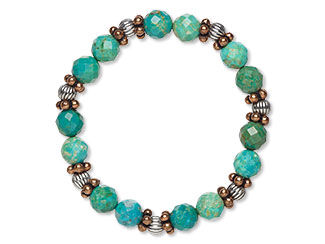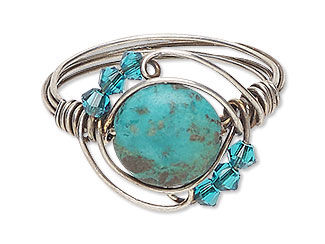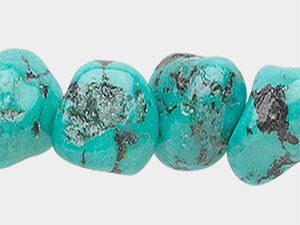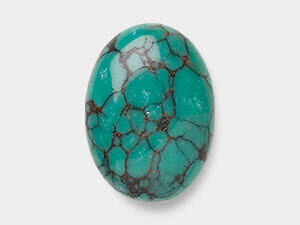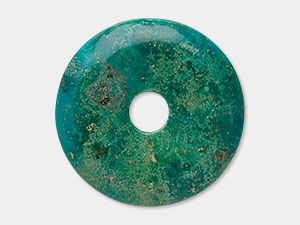Turquoise Meaning and Properties
Turquoise History
Turquoise, a stone ranging in color from blue to green to yellow, is filled with wonderful patterns of brown and black matrix that are composed mainly of copper deposits. Although turquoise has captivated man's imagination for centuries, no one is sure exactly when it was discovered. It is believed that prehistoric people used and prized it for its blue-green colors, because carved pieces have been found in burial and archeological sites spanning the globe.
The beauty and history of turquoise is hard to match! Steeped in history and intrigue, it is truly a captivating stone. It has been used in religion, art, trade, treaty negotiations and of course as treasured jewelry to many kingdoms and peoples. Whether you study ancient Egyptians, Chinese Dynasties, Aztec Mythology or Native American people, it seems clear that turquoise has always been and always will be considered a stone of life, beauty and good fortune.
Turquoise is always a popular choice in jewelry and fashion. Watch this video and learn what turquoise is, where it comes from, its use throughout history and buying tips for this popular blue-green gemstone.

What are the Metaphysical Properties of Turquoise?
Turquoise is one of the official birthstones for the month of December and is heralded as the stone of communication. It is thought to encourage enthusiasm, thus inspiring new projects and bringing to light undiscovered artistic abilities. Turquoise is also believed to provide understanding and encourage attention to detail while attracting prosperity and success.
The sprawling lines of coppery matrix provide a large amount of energy to its wearer. This may be one reason why the stone has long been prized as a powerful talisman with healing properties .
What Chakra is Turquoise?
Chakras are seen as vital energy centers, each tied to different parts of the body, heart and spirit. These centers influence everything from our health and emotions to the way we walk through life. Wearing a chakra bracelet—woven with healing stones—offers a natural, stylish way to keep that energy flowing smoothly. It’s like carrying a little magic with you, helping to keep things balanced and bright from sunrise to sundown. Turquoise is associated with the throat chakra, and is thought to foster good communication, fluent thought and a listening ear, as well as a freedom to seek truth. It also increases resistance to viruses, helping relieve sore throats and allergies.
Throat Chakra (Vishuddha) - Teal or Light Blue
- Location: throat (thyroid)
- Represents: communication; growth via expression; secrets
- Emotional issues: communication; independence; listening; creativity; fluent thought
- Spiritual issues: sense of self; freedom to speak truth
- Physical issues: thyroid; esophagus; speech and other communication problems
- Gemstones: aquamarine, blue lace agate
What is Turquoise Made From?
Turquoise has a waxy luster. It is typically blue-green with brown or black veins of matrix running through it. Some turquoise is dyed to give it an evenly vivid color. Most turquoise is stabilized to improve overall strength and polish.
Turquoise is mined across the globe, and each location yields specific stone colors and characteristics. Turquoise properties range from the bright sky-blue, matrix-free Sleeping Beauty turquoise from Arizona to the rough, organic yellow colors and heavy matrix mined from Africa .
Chalk turquoise is a form of natural turquoise that has a white, chalk-like consistency. It is dyed pleasing colors and stabilized to produce beads that are hard enough to use in jewelry.
- Mineral Information: Copper containing basic aluminum phosphate
- Chemical Composition: CuAl6(I(OH)2/PO4)4.4H2O
- Color: Sky blue, blue-green, green
- Hardness: 5 to 6 (Mohs)
- Specific Gravity: 2.60 – 2.80
- Refractive Index: 1.61 – 1.65
How Do You Clean Turquoise?
Turquoise is a hydrous compound of copper and aluminum, so it loses color when it loses water. To keep your turquoise from becoming dehydrated, it is a good idea to water it, as you would your houseplants, with pure saline water periodically to revive or maintain color. (If salty ocean mist makes the Statue of Liberty , which is made of solid copper, turn green, it will do the same for your turquoise.)
Turquoise is porous, so chemicals can damage it. Use only pure water and a soft cloth to wipe it clean, and you can clean your turquoise frequently without causing damage. The natural oil of your skin is good for turquoise, and it will naturally polish it when you wear it. If it is set in silver, wearing it often will also keep the silver from tarnishing. Silver polish will damage the surface of turquoise.
Don't store turquoise with harder gemstones or other materials that might rub against it and cause damage. Turquoise can fade with sunlight, excessive sweat, chlorine bleach and dishwater.
Turquoise FAQ
Q: Is turquoise one of the oldest gemstones?
A: Across centuries and continents, stories have been passed down celebrating unique turquoise properties, such as its blue hue, reminiscent of sky and sea, the relative ease with which it could be carved, and its availability worldwide. But although turquoise has been used for thousands of years, other gemstones, too have this distinction.
Q: Is turquoise only blue in color?
A: Although turquoise is known for its intense blue hue, it occurs in a variety of shades from blue to aqua, green and even yellow.
Q: Why is turquoise enhanced with treatments?
A: The turquoise properties of being porous, soft and prone to discoloration make it necessary for it to be treated to preserve its integrity and hue. Turquoise can be stabilized to make it more durable or dyed to enhance or change the color.
Q: Is turquoise only used in Western and Native American jewelry?
A: Turquoise has been cherished by cultures around the world since antiquity. While it's widely recognized as a symbol of the American Southwest and holds deep significance in many Native American traditions, turquoise’s history stretches far beyond. From ancient Egypt and Persia to China and Mesoamerica, this vibrant blue-green stone has been used in jewelry, spiritual practices and protective talismans for thousands of years.
Designing with Turquoise
The blue-green of turquoise has been traditionally combined with silver and red coral in southwestern jewelry. Turquoise, with its strong greenish hues, combines well with amber, sparkling crystal, dyed mountain ''jade, '' Hemalyke ™ or serpentine . Textured and patterned beads also work well with turquoise: heishi shells , sunstone , labradorite and rainbow moonstone . For a look that really turns heads, try mixing it with contrasting colors, such as spessartite garnet or fire-orange carnelian .
Chalk turquoise, another variety of turquoise, is available in bright fuchsia pink, lime green and robin egg blue to further expand your designing options. For absolute elegance, use precious metal beads with pure Sleeping Beauty blue turquoise mined from Arizona.
For more information about turquoise properties, read “A Complete Guide to Turquoise.” Or if you’d like to learn more about its history and symbolism, explore “Turquoise: Then and Now.”
A Few Inspirations to Get You Started
Join us for an exciting project on creating a stunning turquoise bracelet adorned with silver accents and findings that will make a bold statement. Follow our easy step-by-step instructions and create your own masterpiece!

Shop for Turquoise
**Please note that all metaphysical or healing properties listed are collected from various sources. This information is offered as a service and not meant to treat medical conditions. Fire Mountain Gems and Beads® does not guarantee the validity of any of these statements.
How did you like this resource? Your feedback helps us provide resources that matter to you most.
Copyright Permissions
All works of authorship (articles, videos, tutorials and other creative works) are from the Fire Mountain Gems and Beads® Collection, and permission to copy is granted for non-commercial educational purposes only. All other reproduction requires written permission. For more information, please email copyrightpermission@firemtn.com.


